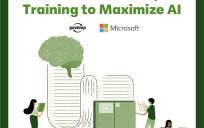You’ll find more than seating at a certain park bench outside a Durham, N.C., library. The solar-powered piece of outdoor furniture, part of the Village Green Project, also measures temperature, wind speed, and air quality.
Traditional air monitors used for federal regulatory purposes cost tens of thousands of dollars, require experts to run them, and are relatively immobile. Although the monitors aren’t the most user-friendly pieces of equipment, the data that comes from them is impeccable.
Next-gen air sensors like those used for the bench are low-cost, portable, and provide data in real-time. Many of the models currently available fit in the palm of a hand. Such capabilities mean that these air sensors will generate far more data than traditional monitors.
For example, if a sensor takes one measurement each minute, that single sensor will produce more than a half-million data points in a year.
Major questions surround that data:
- What is the quality? Does extreme weather affect readings? Does the sensor even measure what it’s supposed to?
- What is the end use? Teachers using sensors in the classroom require less precision and accuracy than a community organizer hoping to show how air pollution affects a neighborhood.
- Who owns the data? How can users find, use, and visualize that data?
- How do local, state, and federal agencies help sensor users understand and interpret data?
Some low-cost sensors are commercially available already, though EPA doesn’t endorse any specific instrument. Our scientists are beginning to understand the strengths and weaknesses of this kind of technology, including the implications for data, big and small.
People in various industries bring up the idea of “big data” as a solution. In fact, it’s more of a beginning.
EPA’s work with air sensors is a microcosm of the broader government movement toward open data. The work also reflects the real-world implications that result from forays into a much-talked-about idea.
- Has your office explored the potential for open data or big data applications?
- How has your organization addressed big data concerns or opportunities?
Dustin Renwick works in conjunction with the Innovation Team in the U.S. Environmental Protection Agency’s Office of Research and Development. The opinions expressed here are the author’s and do not reflect EPA policy, endorsement, or action. EPA does not verify the accuracy or science contained here.
Dustin Renwick is part of the GovLoop Featured Blogger program, where we feature blog posts by government voices from all across the country (and world!). To see more Featured Blogger posts, click here.





Thanks for sharing this – super cool information. Makes me think about what will happen once all this data from sensors is mapped — imagine if you’re buying a house and want to know what the air quality will be like (near a highway/in a city, etc). Just lots of good data that traditionally has been hard to make accessible for traditional public, and useful for daily lives. Thanks again!
You’re right. There’s so much potential with this kind of data across the government. The next five years should be really fun in terms of what will happen as the data load increases and more people work to do interesting things with it.